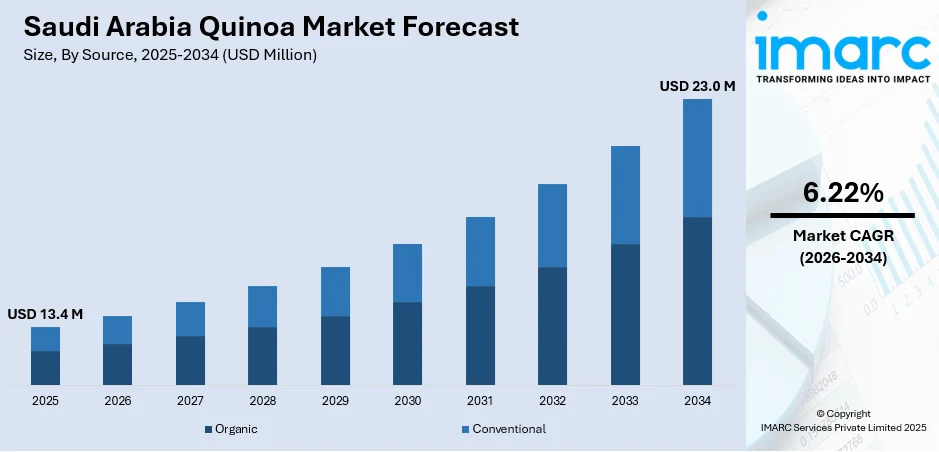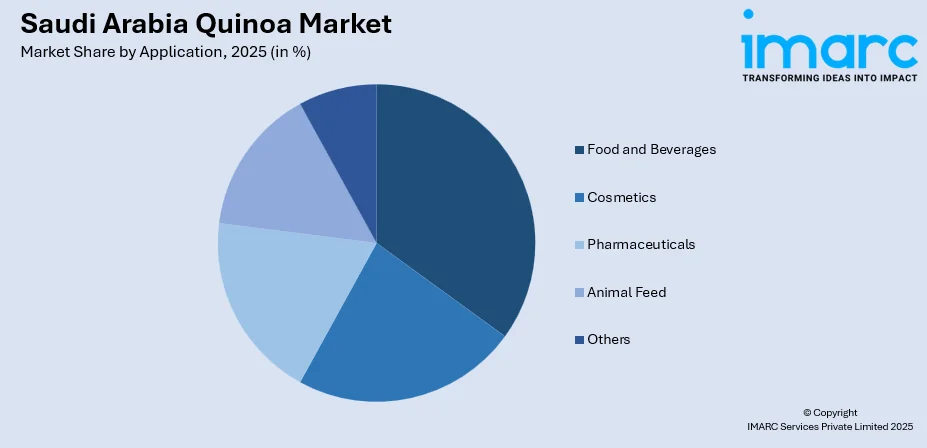
Saudi Arabia Quinoa Market Size, Share, Trends and Forecast by Source, Product Type, Application, Distribution Channel, End Use, and Region, 2026-2034
Saudi Arabia Quinoa Market Overview:
The Saudi Arabia quinoa market size reached USD 13.4 Million in 2025. Looking forward, IMARC Group expects the market to reach USD 23.0 Million by 2034, exhibiting a growth rate (CAGR) of 6.22% during 2026-2034. The market is witnessing steady growth due to increasing health awareness, rising demand for plant-based proteins, and the shift toward healthier diets. Furthermore, quinoa’s nutritional benefits and versatility are driving its adoption in both household and foodservice sectors, boosting market growth.
|
Report Attribute
|
Key Statistics
|
|---|---|
|
Base Year
|
2025 |
|
Forecast Years
|
2026-2034
|
|
Historical Years
|
2020-2025
|
| Market Size in 2025 | USD 13.4 Million |
| Market Forecast in 2034 | USD 23.0 Million |
| Market Growth Rate 2026-2034 | 6.22% |
Saudi Arabia Quinoa Market Trends:
Growing Focus on Health and Wellness
As health and wellness trends continue to gain momentum in Saudi Arabia quinoa is increasingly being adopted due to its impressive nutritional profile. Known for being high in protein, fiber and essential vitamins quinoa is particularly appealing to health-conscious consumers seeking nutrient-dense gluten-free alternatives to traditional grains. This shift towards healthier eating habits is fueling quinoa’s popularity particularly among those following gluten-free or plant-based diets. Quinoa’s versatility allows it to be used in various dishes from salads and bowls to baked goods making it a convenient addition to everyday meals. Additionally, its status as a "superfood" aligns with growing interest in clean-label products that support overall health and wellness. As more consumers prioritize healthy food choices quinoa is becoming a staple in Saudi households. This growing demand is a key driver behind Saudi Arabia quinoa market growth.

To get more information on this market, Request Sample
Rise of Plant-Based Diets
The increasing trend of vegan and vegetarian diets in Saudi Arabia is largely fueling the demand for plant-based proteins such as quinoa. As more people adopt plant-based diets for health, environmental, and ethical purposes quinoa with its complete protein content have emerged as a sought-after choice. While most plant-based proteins lack all nine essential amino acids quinoa offers all of them making it a great addition to vegan and vegetarian diets. Moreover, the high fiber and gluten-free nature of quinoa render it an ideal ingredient for inclusion in numerous foods ranging from salads and stir-fries to smoothies and baked foods. Growing plant-based consumption is also being aided by rising awareness regarding the health effects of minimizing the consumption of animal proteins especially when it comes to heart health and digestion. This shift is playing a crucial role in expanding the popularity of quinoa contributing to a growing Saudi Arabia quinoa market share.
Product Innovation
Product innovation is a key driver in the growing popularity of quinoa in Saudi Arabia. To meet the increasing consumer demand for convenience and health-conscious options companies are introducing a diverse range of quinoa-based products. Ready-to-eat meals such as quinoa salads and grain bowls are becoming popular for busy and health-conscious individuals. Additionally, quinoa snacks like chips, protein bars and granola are gaining traction as on-the-go nutritious options for consumers. The versatility of quinoa allows it to be incorporated into various forms catering to different dietary preferences such as gluten-free and vegan diets. This innovation in product offerings not only attracts health-focused consumers but also makes quinoa more accessible and convenient for everyday use. As the demand for healthy ready-to-consume foods continues to rise quinoa-based products are expected to play a larger role contributing to the positive Saudi Arabia quinoa market outlook.
Saudi Arabia Quinoa Market Segmentation:
IMARC Group provides an analysis of the key trends in each segment of the market, along with forecasts at the country and regional levels for 2026-2034. Our report has categorized the market based on source, product type, application, distribution channel, and end use.
Source Insights:
- Organic
- Conventional
The report has provided a detailed breakup and analysis of the market based on the source. This includes organic and conventional.
Product Type Insights:
- Red Quinoa
- Black Quinoa
- White Quinoa
- Others
A detailed breakup and analysis of the market based on the product type have also been provided in the report. This includes red quinoa, black quinoa, white quinoa, and others.
Application Insights:

- Food and Beverages
- Cosmetics
- Pharmaceuticals
- Animal Feed
- Others
A detailed breakup and analysis of the market based on the application have also been provided in the report. This includes food and beverages, cosmetics, pharmaceuticals, animal feed and others.
Distribution Channel Insights:
- Supermarkets and Hypermarkets
- Traditional Retail Stores
- Convenience Stores
- Online
- Others
A detailed breakup and analysis of the market based on the distribution channel have also been provided in the report. This includes supermarkets and hypermarkets, traditional retail stores, convenience stores, online, and others.
End Use Insights:
- Ingredient
- Packaged Food
A detailed breakup and analysis of the market based on the end use have also been provided in the report. This includes ingredient and packaged food.
Regional Insights:
- Northern and Central Region
- Western Region
- Eastern Region
- Southern Region
The report has also provided a comprehensive analysis of all the major regional markets, which include Northern and Central Region, Western Region, Eastern Region, and Southern Region.
Competitive Landscape:
The market research report has also provided a comprehensive analysis of the competitive landscape. Competitive analysis such as market structure, key player positioning, top winning strategies, competitive dashboard, and company evaluation quadrant has been covered in the report. Also, detailed profiles of all major companies have been provided.
Saudi Arabia Quinoa Market Report Coverage:
| Report Features | Details |
|---|---|
| Base Year of the Analysis | 2025 |
| Historical Period | 2020-2025 |
| Forecast Period | 2026-2034 |
| Units | Million USD |
| Scope of the Report | Exploration of Historical Trends and Market Outlook, Industry Catalysts and Challenges, Segment-Wise Historical and Future Market Assessment:
|
| Sources Covered | Organic, Conventional |
| Product Types Covered | Red Quinoa, Black Quinoa, White Quinoa, Others |
| Applications Covered | Food and Beverages, Cosmetics, Pharmaceuticals, Animal Feed, Others |
| Distribution Channels Covered | Supermarkets and Hypermarkets, Traditional Retail Stores, Convenience Stores, Online, Others |
| End Uses Covered | Ingredient, Packaged Food |
| Regions Covered | Northern and Central Region, Western Region, Eastern Region, Southern Region |
| Customization Scope | 10% Free Customization |
| Post-Sale Analyst Support | 10-12 Weeks |
| Delivery Format | PDF and Excel through Email (We can also provide the editable version of the report in PPT/Word format on special request) |
Key Questions Answered in This Report:
- How has the Saudi Arabia quinoa market performed so far and how will it perform in the coming years?
- What is the breakup of the Saudi Arabia quinoa market on the basis of source?
- What is the breakup of the Saudi Arabia quinoa market on the basis of product type?
- What is the breakup of the Saudi Arabia quinoa market on the basis of application?
- What is the breakup of the Saudi Arabia quinoa market on the basis of distribution channel?
- What is the breakup of the Saudi Arabia quinoa market on the basis of end use?
- What is the breakup of the Saudi Arabia quinoa market on the basis of region?
- What are the various stages in the value chain of the Saudi Arabia quinoa market?
- What are the key driving factors and challenges in the Saudi Arabia quinoa market?
- What is the structure of the Saudi Arabia quinoa market and who are the key players?
- What is the degree of competition in the Saudi Arabia quinoa market?
Key Benefits for Stakeholders:
- IMARC’s industry report offers a comprehensive quantitative analysis of various market segments, historical and current market trends, market forecasts, and dynamics of the Saudi Arabia quinoa market from 2020-2034.
- The research report provides the latest information on the market drivers, challenges, and opportunities in the Saudi Arabia quinoa market.
- Porter's five forces analysis assist stakeholders in assessing the impact of new entrants, competitive rivalry, supplier power, buyer power, and the threat of substitution. It helps stakeholders to analyze the level of competition within the Saudi Arabia quinoa industry and its attractiveness.
- Competitive landscape allows stakeholders to understand their competitive environment and provides an insight into the current positions of key players in the market.
Need more help?
- Speak to our experienced analysts for insights on the current market scenarios.
- Include additional segments and countries to customize the report as per your requirement.
- Gain an unparalleled competitive advantage in your domain by understanding how to utilize the report and positively impacting your operations and revenue.
- For further assistance, please connect with our analysts.
 Request Customization
Request Customization
 Speak to an Analyst
Speak to an Analyst
 Request Brochure
Request Brochure
 Inquire Before Buying
Inquire Before Buying




.webp)




.webp)












